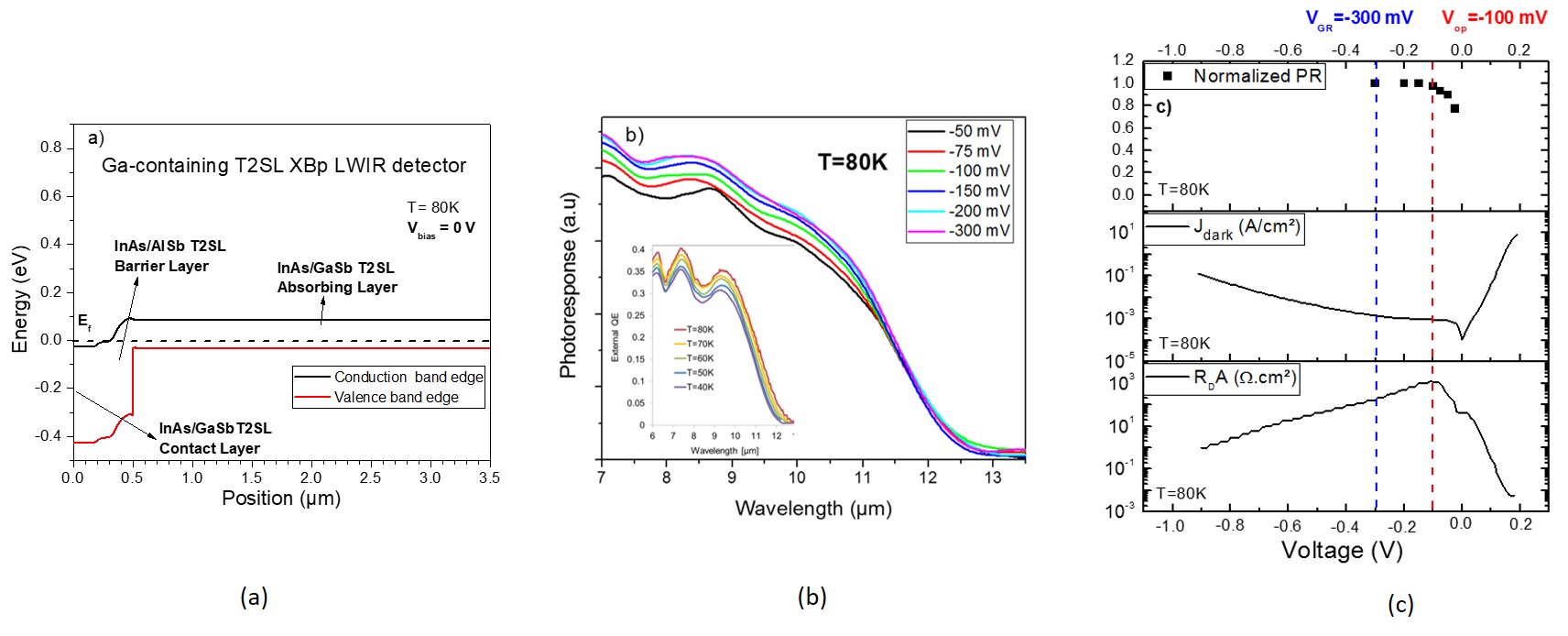Quantum Detectors
Quantum Detectors
Staff:P. Christol, J.P. Perez, J.B. Rodriguez
PhD students: M. Delmas (2012-2015) ; Q. Durlin (CIFRE-Défense DGA-Sofradir, 2014-2017) ; R. Alchaar (2016-2019) ; U. Zavala-Moran (CONACYT, 2017-2020), M. Bouschet (CIFRE Lynred, 2019-2022).
Projects:VITRAIL (PEA DGA 2013-2015), HOT-DETECTOR (PEA DGA 2015-2017), ESA (ESA contract 2016-2019),HOT-MWIR(ANR C24 2018-2022), CNES (R&T CNES 2019-2022), ONERA (ONERA contract 2019-2022)
Main collaborations: I. Ribet-Mohamed, ONERA-Palaiseau (France), N. Péré Laperne, Lynred (France), L. Höglund, IRnova (Sweden).
Objective:
The objective is the fabrication and the study of high performance cooled infrared (IR) quantum detectors made of Ga-containing InAs/GaSb type II superlattices (T2SL) or Ga-free InAs/InAsSb T2SL in new barrier architectures. These Sb-based photodetectors should be able to improve the signal to noise ratio to satisfy the criteria of SWAP (Size, Weight and Power) requirements with high operating temperature (T > 150K) in the Midwave IR (MWIR 3-5µm) and to reach high performance in the longwave IR (LWIR 8-12µm) and Very Longwave (VLWIR l>12µm) spectral domains to address specific spatial or military applications.
Recent results:
Barrier structures (XBn or XBp) are now the usual design of antimonide-based (Sb-based) cooled IR quantum detectors. During the last period, MWIR Ga-free T2SL and LWIR/VLWIR Ga-containing T2SL have been studied.
To address the MWIR broadband and operate at temperature as high as 150K, InAs/InAsSb Ga-free T2SL in XBn configurations have been grown by MBE on GaSb substrate. In the framework of the ANR project HOT-MWIR, involving IES, LPENS, ILV, 3-5 Lab, ONERA and Lynred (ex Sofradir) the first demonstration of XBn Ga-free T2SL detector, using n-type AlAsSb alloy as barrier layer, has been reported. Compared to MWIR Ga-containing MWIR pin detector, such device permits an improvement of temperature operation, showing cut-off wavelength of 4.85 µm at 150K and exhibiting dark current density as low as 2×10-6A/cm2at 150K and Vbias= -200mV.

Fig.1:Ga-free InAs/InAsSb T2SL XBn MWIR quantum detector:(a) design of the XBn structure, (b) photoresponse spectra at different temperature, (c) dark current density as a function of voltage
In the context of the ESA project, involving IES, IRnova and AIRBUS DS, Ga-containing InAs/GaSb T2SL XBp detectors focused the LWIR and VLWIR spectral domains. The first XBp detector structure, using p-type InAs/AlSb T2SL as barrier layer, has been fabricated and characterized. Normalized photoresponse spectra, dark current density (Jdark) and differential resistance area product (RdA) as a function of the voltage are connected in order to extract particular bias such as the operating bias Vopand the VGRbias for which the G-R current begins to dominate the dark current of the diode.

Fig 2.:Ga-containing InAs/GaSb T2SL XBp LWIR quantum detector: (a) design of the XBp structure, (b) photoresponse spectra at different bias voltage and temperature, (c) connected experimental characterizations made of normalized photoresponse, dark current density and differential resistance area product (RdA) as a function of the voltage at T = 80K.
Next step for T2SL technology operating in the LWIR/VLWIR dedicated for space application is to evaluate radiation tolerance under proton fluence. In collaboration with AIRBUS DS, this objective is currently studied in a R&T CNES project.